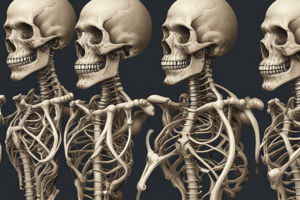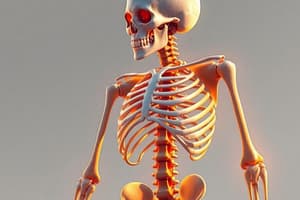Podcast
Questions and Answers
What type of joint allows for the most freedom of movement?
What type of joint allows for the most freedom of movement?
- Plane joint
- Hinge joint
- Ball and socket joint (correct)
- Pivot joint
Which type of joint has both convex and concave articular surfaces?
Which type of joint has both convex and concave articular surfaces?
- Plane joint
- Saddle joint (correct)
- Condyloid joint
- Hinge joint
Which plane of motion is allowed by a hinge joint?
Which plane of motion is allowed by a hinge joint?
- Abduction and adduction
- Circumduction
- Rotation
- Flexion and extension (correct)
What type of joint allows for rotation around a single axis?
What type of joint allows for rotation around a single axis?
Which type of joint allows for flexion, extension, abduction, and adduction?
Which type of joint allows for flexion, extension, abduction, and adduction?
What is the primary type of movement allowed by a uniaxial joint?
What is the primary type of movement allowed by a uniaxial joint?
What is the main function of a synovial joint?
What is the main function of a synovial joint?
Which of the following is an example of a cartilaginous joint?
Which of the following is an example of a cartilaginous joint?
What is the primary function of the articular cartilage in a synovial joint?
What is the primary function of the articular cartilage in a synovial joint?
Which of the following joints is classified as a synarthrosis?
Which of the following joints is classified as a synarthrosis?
What is the primary function of the synovial membrane in a synovial joint?
What is the primary function of the synovial membrane in a synovial joint?
Which of the following joints is classified as an amphiarthrosis?
Which of the following joints is classified as an amphiarthrosis?
Flashcards are hidden until you start studying
Study Notes
Types of Joints
- Diarthroses predominate in the limbs and are also called synovial joints or diarthrodial joints.
Synovial Joints
- Plane: Flat articular surfaces that allow for short gliding movements.
- Hinge: Cylindrical end of one bone fits into the trough of another bone, allowing for angular movement in one plane.
- Pivot: Rounded end of one bone fits into a ring formed by another bone, allowing for rotation.
- Condyloid: Egg-shaped articular surface fits into the oval concavity in another, allowing for flexion, extension, abduction, and adduction.
- Saddle: Has both convex and concave areas, allowing for flexion, extension, abduction, adduction, and circumduction.
- Ball and socket: Spherical head of one bone fits into a round socket in another, allowing for the most freedom of movement, including flexion, extension, abduction, adduction, circumflexion, and rotation.
Classification of Joints
- Classification based on function: Synarthroses, Amphiarthroses, Diarthroses.
- Classification based on structure: Fibrous joints, Cartilaginous Joints, Synovial Joints.
Classification of Joints by Movement/Function
- Synarthroses: immovable joints (sutures).
- Amphiarthroses: slightly movable joints (cartilaginous connection).
- Diarthroses: freely movable joints (synovial).
Classification of Joints by Structure
- Fibrous joints: composed of fibrous (inelastic) connective tissue, non-movable.
- Cartilaginous Joints: formed by cartilage, semimovable.
- Synovial Joints: movable joints, contain a joint capsule of synovial membrane.
Synovial Joints
- No direct union between the bone ends, joint cavity inside the articular capsule is filled with synovial fluid.
- Extracapsular ligaments hold the bones in position, Intracapsular ligaments control degree and direction of movement.
- Articular surface is very smooth and covered with cartilage called hyaline or articular cartilage.
Arthrology
- Arthrology is the scientific study of joints and articulations.
Studying That Suits You
Use AI to generate personalized quizzes and flashcards to suit your learning preferences.




